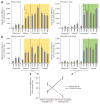Hierarchical cognitive control deficits following damage to the human frontal lobe
- PMID: 19252496
- PMCID: PMC2990342
- DOI: 10.1038/nn.2277
Hierarchical cognitive control deficits following damage to the human frontal lobe
Abstract
Cognitive control permits us to make decisions about abstract actions, such as whether to e-mail versus call a friend, and to select the concrete motor programs required to produce those actions, based on our goals and knowledge. The frontal lobes are necessary for cognitive control at all levels of abstraction. Recent neuroimaging data have motivated the hypothesis that the frontal lobes are organized hierarchically, such that control is supported in progressively caudal regions as decisions are made at more concrete levels of action. We found that frontal damage impaired action decisions at a level of abstraction that was dependent on lesion location (rostral lesions affected more abstract tasks, whereas caudal lesions affected more concrete tasks), in addition to impairing tasks requiring more, but not less, abstract action control. Moreover, two adjacent regions were distinguished on the basis of the level of control, consistent with previous functional magnetic resonance imaging results. These results provide direct evidence for a rostro-caudal hierarchical organization of the frontal lobes.
Figures




References
-
- Badre D, Wagner AD. Selection, integration and conflict monitoring; assessing the nature and generality of prefrontal cognitive control mechanisms. Neuron. 2004;41:473–487. - PubMed
-
- D’Esposito M, et al. The neural basis of the central executive system of working memory. Nature. 1995;378:279–281. - PubMed
-
- D’Esposito M, Postle BR, Rypma B. Prefrontal cortical contributions to working memory: evidence from event-related fMRI studies. Exp Brain Res. 2000;133:3–11. - PubMed
-
- Duncan J. An adaptive coding model of neural function in prefrontal cortex. Nat Rev Neurosci. 2001;2:820–829. - PubMed
-
- Fuster JM. The Prefrontal Cortex: Anatomy, Physiology and Neuropsychology of the Frontal Lobe. Lippincott-Raven Publishers; Philadelphia, Pennsylvania: 1997.
Publication types
MeSH terms
Substances
Grants and funding
LinkOut - more resources
Full Text Sources
Other Literature Sources
Miscellaneous

